- Removable Partial Dentures
- Tooth Extraction: Post-Operative Instructions
- Your Wisdom Teeth
- Taking Care of Your Teeth and Gums
- Basic Flossing
- Do You Have a Cracked Tooth?
- Periodontal Disease: Your Complete Guide
- Basic Brushing
- Periodontal Disease: Keep Your Gums Healthy
- Fluoride: Nature's Cavity Fighter
- Hate To Floss? 3 Other Ways to Clean Between Your Teeth
- Handling Your Child's Dental Emergency
- Get the Facts about Mouth and Throat Cancer
- Oral Health and the HPV Vaccine
- Do You Grind Your Teeth?
- Tooth Decay in Baby Teeth
- Do You Have Sleep Apnea?
- Your Single Tooth Implant
- Your Child's Teeth
- Tobacco and Oral Health
- Seal Out Decay
- Temporomandibular Disorders (TMD)
- Healthy Smiles for Mother and Baby
- Healthy Mouth, Healthy Body: Making the Connection
- Baby Teeth: When They Come In, When They Fall Out
- Thumb Sucking, Finger Sucking and Pacifier Use
- Sip and Snack All Day? Risk Decay!
- 3 Tooth Replacement Options
- Tooth Erosion
- Tooth Decay
- Treating Cavities
- Should You Take Antibiotics before Your Dental Treatment?
- Mouthguards and Sports Safety
- Gum Recession Causes and Treatments
- Dental X-Ray Exams
- Diabetes and Your Oral Health
- Scaling and Root Planing
- Pregnancy and Oral Health
- Your Dentures
- Your Child's First Visit to the Dentist
- Root Canal Therapy Can Save Your Tooth
- Periodontal Disease - Don't wait until it hurts
- Why Do I Need a Bridge?
- Why Do I Need a Crown?
- Your Smile - An Owner's Manual
- Dental Sealants Protecting teeth, preventing decay
- Happiness is a Healthy Smile
- Dental Veneers - Improve Your Smile
- Tooth Whitening for a Brighter Smile
- Why Baby Teeth Are Important
- Dry Mouth
- Sealant Quick Reference
- Caries en Dientes de Leche
- Why Doesn't My Insurance Pay for This?
- Periodontal Maintenance: Stay on Top of Gum Disease
- Flossing Quick Reference
- Brushing Quick Reference
- Your Child's Teeth: Ages 6–12
- Your Child's Teeth: From Birth to Age 6
- Dental Implants: Are they an option for you
- Mouth Sores and Spots
- Sipping, Snacking and Decay
- Improving Your Smile
- Your Child's First Dental Visit
Tooth Decay is a Disease That Damages and Breaks Down Teeth
Your teeth have a hard, outer layer, called enamel (e-NAM-uhl); a middle layer, called dentin; and a center, which contains the nerves and blood vessels, known as the pulp chamber.
Tooth decay can affect each layer of your tooth, and the more layers that are affected, the worse the damage.
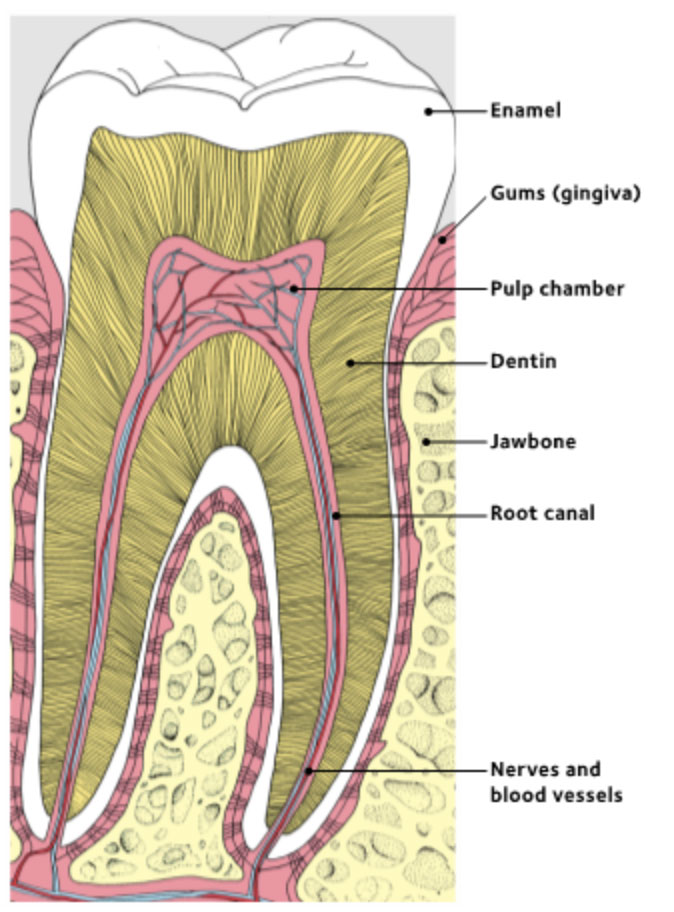
What Causes Tooth Decay?
Your teeth are covered by a sticky film of bacteria called plaque (pronounced PLACK). When plaque is left on your teeth, the bacteria in the plaque use sugar in food and drinks to make acid. This acid attacks your tooth enamel. Eventually, your enamel can break down from these acids and cavities can start to form. Once a cavity forms, it can’t be reversed. Cavities can only be treated and repaired by a dentist, usually with a filling.
If tooth decay is not treated, you may feel pain, the infection can spread to other parts of your mouth, and you may even lose teeth. People with tooth pain may have trouble eating and sleeping and may miss days of work or school.
Progress of tooth decay
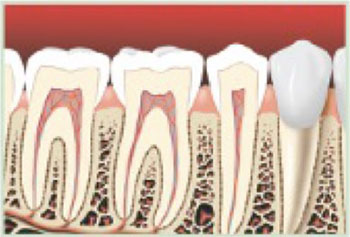
Healthy teeth and roots without signs of decay
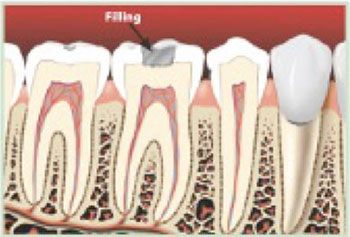
Early decay may not be easy for you to notice, especially if it forms in an area that can't be seen like under a filling
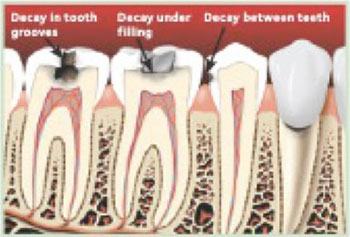
Decay under the surface may be larger than it looks from the outside
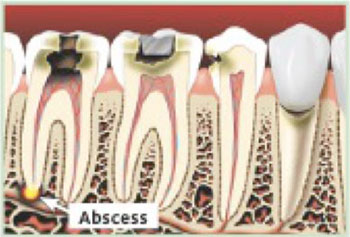
If not treated, tooth decay can cause an abcess and can lead to serious infections
Signs and Symptoms of Tooth Decay
- Brown, black, or white spots on your teeth
- A visible hole in your tooth
- Bad breath that doesn’t go away with brushing or mouthrinse
- Loose fillings
- Sensitivity to heat or cold
- Tooth pain
You may not notice any signs or symptoms at all, so it’s important to see your dentist regularly. He or she will examine your teeth and take x-rays if needed.
Common Places Where Decay Forms
Tooth decay often occurs between teeth and in the grooves of back teeth, where bits of food collect. Toothbrush bristles often do not get into these grooves. Back teeth are also harder to keep clean because they are not as easy to reach. Another place decay can form is at the tooth root. Cavities there may go below the gumline.
Treating Tooth Decay
Treatment depends on the size and location of the decay. Your dentist can explain what treatment is best, depending on how much the decay there is.
- For decay that is caught early, a fluoride (FLOOR-eyed) treatment may be all that is needed. Fluoride is a natural mineral that can help protect your tooth enamel and reverse early signs of decay.
- If decay has formed a cavity, you’ll need a filling.
- If the cavity is large, you may need a crown.
- If the cavity has caused the pulp of your tooth to be infected or inflamed, you may need root canal therapy.
- For a tooth badly damaged by a cavity, it may need to be removed and replaced with an implant or bridge.
It is faster, easier and less expensive to prevent tooth decay than to repair or replace a decayed tooth.
People of all ages can get tooth decay
Your risk may increase if you:
- have sugary foods and drinks often throughout the day
- have a dry mouth all or most of the time
- have weak enamel due to family history or a childhood illness
- do not practice good oral hygiene habits
The bacteria that cause tooth decay can also be passed from one mouth to another by kissing, sharing a cup or spoon or anything else that carries saliva. For this reason, you should not share toothbrushes with anyone.
What you can do to lower your risk of tooth decay
- Brush your teeth with a fluoride toothpaste two times a day for two minutes each time.
- Clean between your teeth every day with floss or another between-the-teeth cleaner.
- Limit how often you snack and sip on sugary foods and drinks.
- Drink water that contains fluoride. Tap water often has added fluoride to keep your teeth strong.
- Visit your dentist regularly for exams and professional teeth cleanings.
- Consider dental sealants applied to back teeth (molars). Sealants act as a barrier, protecting enamel by sealing out bacteria and food particles.
- Use oral care products that have the American Dental Association’s Seal of Acceptance. This means they have been tested for safety and effectiveness.
Visit Our Office
Office Hours
- MON8:30 am - 5:00 pm
- TUE8:30 am - 5:00 pm
- WEDClosed
- THUClosed
- FRI8:30 am - 5:00 pm
- SAT9:00 am - 2:00 pm
- SUNClosed